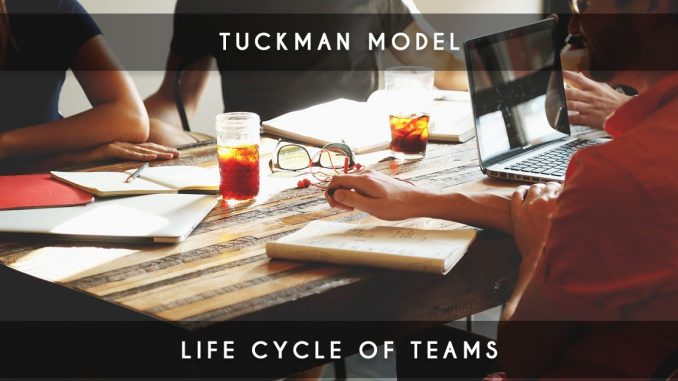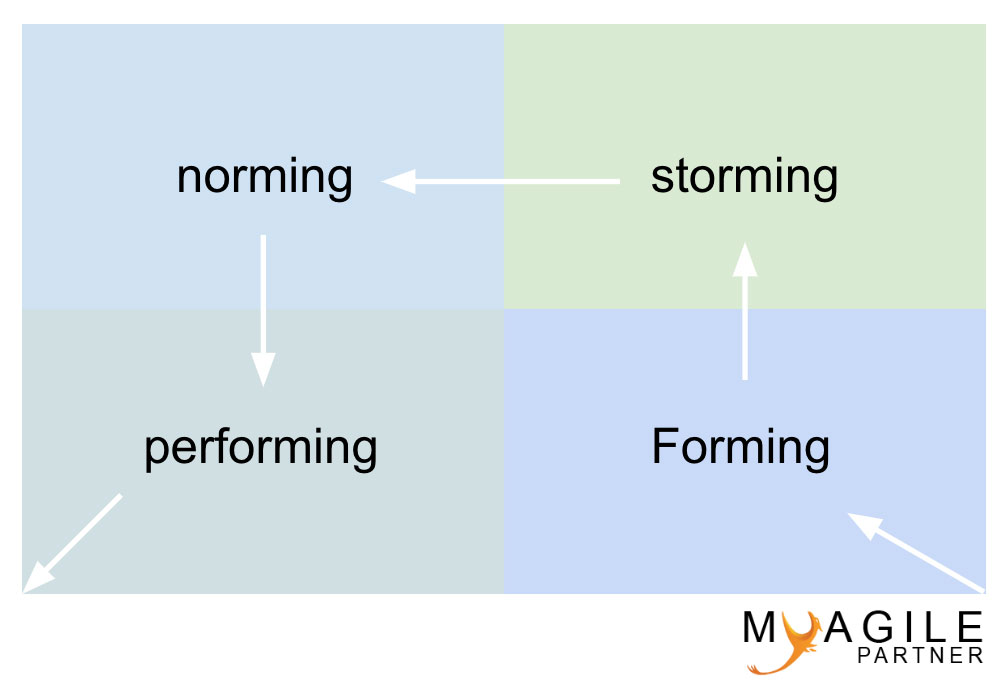
Exploring the Tuckman Model: Understanding Team Cohesion
Dr. Bruce Wayne Tuckman came up with a model on team cohesion called the Tuckman model. It is interesting to see this Tuckman model which is based on the result of an analysis of more than 50 studies on team theory.
Before delving further, it’s important to note that Dr. Bruce Wayne Tuckman is a prominent American psycho-sociologist with widespread recognition in his field.
The Tuckman Model
The Tuckman model isn’t a recent development; it was introduced in 1965. The model suggests four stages in the development of small group cohesion: Forming, Storming, Norming, and Performing.

In 1977, a fifth step, “Adjourning,” was added to the model.
Let’s now explore these five steps in detail. Despite being a little dated, this model remains relevant in our present-day organizations. Its enduring relevance is due to its alignment with current practices.
This model is often employed by agile coaches when coaching new teams.
Tuckman Model: 1. Forming
When a group forms, its members embark on a journey of mutual discovery. Interactions among group members are established, which may take some time. Larger groups facilitate a greater number of interactions.
During this initial phase of team cohesion, various individual profiles start to emerge, such as leaders, followers, and even complainers. Team members define their roles and responsibilities, and emotional connections begin to form. It’s intriguing to witness the directions certain profiles take during this discovery phase.
Emotional connections and commonalities will also contribute to the bonding within the team. Tensions among team members are rare during this phase of exploration. Overall, this phase is marked by a sense of discovery and motivation.
Tuckman Model: 2. Storming
There invariably comes a point when the situation takes a turn for the worse, for various reasons:
– Monotonous routines lead to weariness.
– Tight deadlines are suddenly imposed.
– Mission and objectives become increasingly unclear.
– Ego clashes arise among members.
– Interactions between members turn negative.
– Some members struggle with the behaviors of others.
– Certain sectors face periodic challenges.
It’s crucial for the team to understand the importance of minimizing the duration of this phase, as team productivity tends to decline during this period.
In an agile team, the agile coach and the scrum master need to remain vigilant in addressing tensions among team members, ensuring continuous improvement, and periodically refreshing practices.
Without proactive intervention, this stage might persist for an extended duration.
Tuckman Model: 3. Norming
After navigating the storming phase, teams transition into a distinct phase. Once potential conflicts have been resolved and team members have found their respective places, the norming phase commences. Standardization and effective teamwork become more prominent.
During this phase, it’s beneficial for the scrum master (or agile coach) to conduct Team Building activities. These activities promote team autonomy and continuous improvement.
This phase also emphasizes elements crucial to employee well-being, as supported by various studies:
– Skill development
– Autonomy and accountability
– Effective communication
– Recognition of contributions
– Favorable working conditions
Many large companies today recognize the significance of employee well-being in driving productivity. However, there is still a tendency to underestimate the importance of salary in this context.
Tuckman Model: 4. Performing
When the team reaches optimal conditions for work, the performing phase begins. Productivity continues to rise, governance is well-defined, and interactions and bonds among team members strengthen. Generally, the team becomes more cohesive and united around shared objectives.
To ensure that the team’s practices continue to improve, it’s recommended to have a coach onboard. It’s worth noting that coaches often emphasize the risk of reliving the previous phases when introducing changes or adding new team members.
Tuckman Model: 5. Dissolution
Unfortunately, groups are not perpetually sustainable, eventually entering the dissolution phase, which poses challenges for companies. External events can put the entire group at risk.
Historically, when a team member left the company, it was not uncommon for up to 50% of the team (around 7 members) to follow suit within six months. Companies were aware of these risks but often hoped to delay the inevitable.
Thankfully, modern companies are paying more attention to these issues and making thoughtful decisions. Interestingly, a contrasting scenario has emerged, where a company decides to retain a team member disliked by some decision-makers to prevent mass departures. This particular team member is highly valued by the team, underscoring the real risks involved.
Considering the Lifespan of Teams
Some managers, although not always openly admitting it, foresee a limited lifespan for teams (around 1.5 to 2 years) due to concerns about declining performance over time. Opinions on this matter vary.
However, in certain IT hubs like Paris and Geneva, it has become increasingly rare for teams to survive beyond two years. High turnover, driven by a demand for IT professionals, poses significant challenges for maintaining long-standing teams.




Be the first to comment